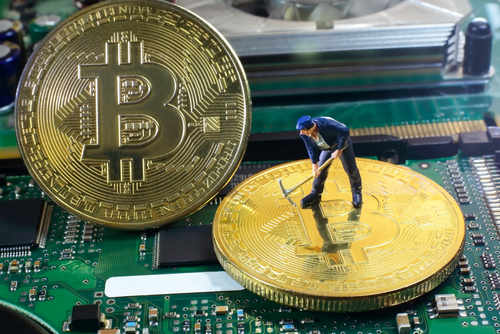The Cost of a Bitcoin
Students in any Money & Banking class are likely to learn that it costs more than a penny to make a penny. Fiat paper money, of course, is worth only a few cents of raw materials. (You could probably win a bar bet by knowing the different costs the Treasury charges the Fed for each denomination. The most expensive, it turns out, is the $50). We have written several features recently at AIER about blockchain and bitcoin, one primary application of blockchain technology. So how much does it cost to make a bitcoin?
Regular readers know that new bitcoins are created, or “mined,” when computers running bitcoin software add a new block to the bitcoin blockchain. The difficulty of creating a “proof-of-work,” a computationally-intensive process that causes other users to accept this new block, is automatically adjusted by the system to keep the time between block creation similar, so the difficulty is an increasing function of the computing power on the network. As the price of bitcoin has risen, bitcoin mining has become increasingly efficient and professionalized, with the majority of mining being done by “mining pools” that use specialized hardware and even locating their “mines” in cold-weather areas to reduce costs needed to keep their mining computers from overheating. However, the increased revenue from bitcoin has led to more and more competition and the increased processing power needed to earn a new bitcoin is rising faster than the efficiency gains in energy use per unit of processing power can keep up with. Essentially, bitcoin is using more and more energy.
The figures are striking. The website Digiconomist estimates the bitcoin network’s annualized mining costs at over half a billion dollars – about half the size of the estimated annualized value of newly mined bitcoins. The energy consumption of the network could power around a million U.S. households. This is still a healthy profit margin for miners, but bitcoin critics and advocates alike are worried about it. For one thing, it concentrates mining into the hands of a few mining pools, which could in the long-run jeopardize the decentralization at the heart of the blockchain’s appeal. For another, it imposes externality costs on the pollution costs of generating extra electricity. This may be optimal, if bitcoin is providing a valuable service, but only if it is truly necessary. Mining costs are only worthwhile to the extent there are no cheaper ways to maintain the integrity of the blockchain.
Bitcoin entrepreneurs are exploring ways of attacking this problem. Bitcoin Unlimited aims to decrease congestion, thus making the existing mining techniques more efficient in terms of total transactions. As Vice’s Christopher Malmo points out, credit card companies process transactions thousands of transactions at the same cost as one bitcoin transaction. While Others have suggested ways to replace the proof-of-work with other methods that would require less power without sacrificing the security benefits of the method. These kinds of innovations may make bitcoin – or a future cryptocurrency – both more sustainable, efficient and widespread.










